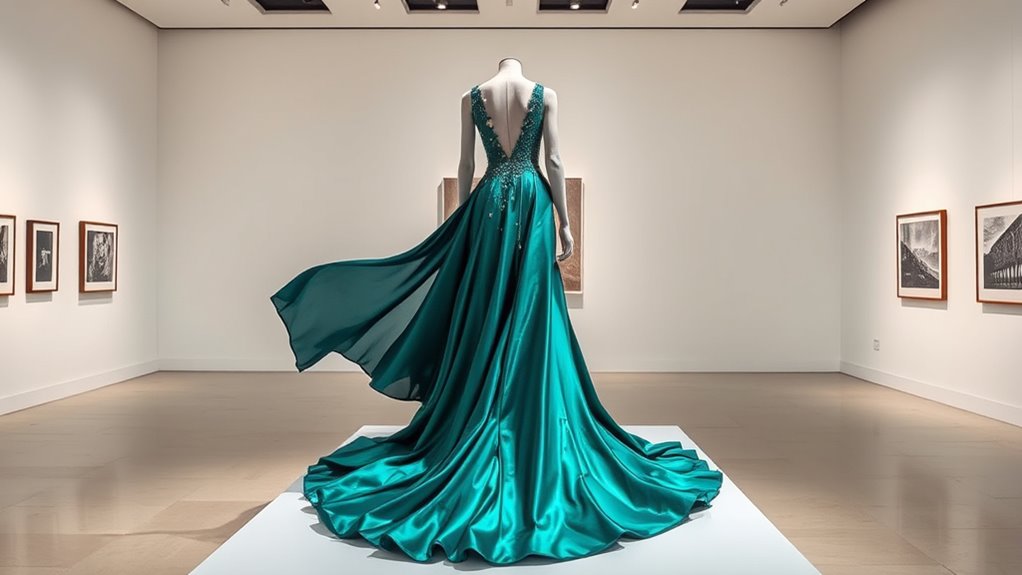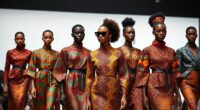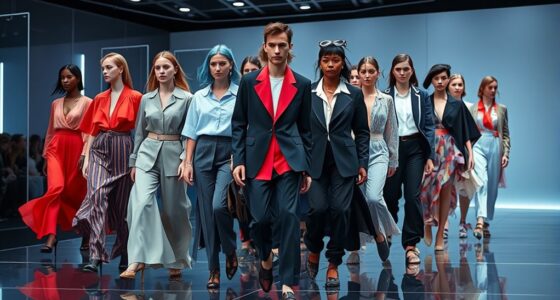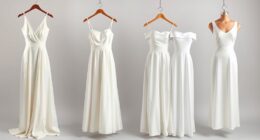You’ll see that fashion now blurs the lines between clothing and art, transforming garments into creative statements rooted in cultural identity and societal change. Designers often collaborate with artists, creating limited-edition pieces that challenge traditional fashion boundaries and become collectible artworks displayed in museums. These exhibits highlight fashion as a dynamic form of artistic expression, reflecting history, social issues, and cultural stories. If you’re curious about how this evolution continues, there’s more to explore.
Key Takeaways
- Fashion garments are increasingly showcased in museums alongside fine art, emphasizing their role as cultural artifacts.
- Runway designs often incorporate artistic collaborations, transforming clothing into visual masterpieces.
- Exhibits highlight the creative process behind fashion, elevating it beyond functional wear to artistic expression.
- Fashion inspired by art history and social issues creates emotionally resonant collections displayed as cultural stories.
- The evolving fashion landscape challenges traditional notions of art, positioning clothing as a dynamic form of artistic innovation.

Is fashion truly just clothing, or is it a form of art that challenges traditional boundaries? When you consider its role as an artistic expression, you realize that fashion has a powerful history rooted in cultural identity and societal change. Its historical influence is undeniable, shaping how we see ourselves and others while reflecting the times we live in. Over the centuries, designers have pushed the limits of what clothing can be, transforming garments from mere functionality into bold statements of creativity. These shifts often mirror broader artistic movements, blurring the lines between wearable art and visual masterpieces. This evolution is evident in how fashion bridges the gap between everyday life and the world of art galleries and museums.
One of the key elements that elevate fashion to an art form is designer collaborations. When visionary designers team up with artists, musicians, or other creative minds, they often produce extraordinary pieces that transcend conventional fashion boundaries. Think of collaborations that fuse haute couture with fine art, turning runway shows into immersive experiences. These partnerships challenge the traditional notion of clothing as disposable or purely utilitarian, elevating it to a platform for innovation and cultural commentary. For instance, collaborations between fashion houses and contemporary artists often result in limited-edition collections that are as much about artistic expression as they are about wearability. These pieces become collectible artworks, displayed in museums and exhibitions to showcase fashion’s artistic potential.
Designer collaborations transform fashion into wearable art, blending innovation with cultural commentary and museum-worthy creations.
You can see the influence of these collaborations in recent museum exhibits that highlight fashion as art. Curators now often feature runway garments alongside paintings, sculptures, and multimedia installations, emphasizing the creative process behind each piece. This shift invites you to see fashion not just as a commercial industry but as a dynamic form of artistic dialogue. Designers draw inspiration from art history, cultural movements, and social issues, creating collections that evoke emotion and provoke thought. When these garments are displayed in museums, they gain a new layer of significance—no longer just clothing but artifacts of cultural expression. Recognizing the importance of visual storytelling in fashion further underscores how clothing can serve as a powerful medium for artistic communication.
In embracing this perspective, you recognize that fashion’s historical influence and designer collaborations have helped reshape how society perceives clothing. It’s no longer simply about trends or personal style but about celebrating creativity in all its forms. Fashion, in this light, becomes an evolving art exhibit—an ongoing dialogue between creators and audiences, constantly challenging what art can be.
Frequently Asked Questions
How Do Designers Select Pieces for Museum Displays?
When selecting pieces for museum displays, you consider both fabric preservation and curatorial expertise. You look for garments that showcase innovative design and cultural significance while ensuring the fabrics are durable enough for long-term preservation. You also assess how each piece fits into the overall story or theme of the exhibit. By balancing artistic value with practical preservation needs, you create a compelling, lasting showcase of fashion as art.
What Criteria Distinguish Fashion as Fine Art?
You might not realize it, but fashion can be a masterpiece that rivals classic art. When you see pieces distinguished as fine art, it’s because they showcase extraordinary textile craftsmanship and groundbreaking conceptual innovation. These designs transcend mere clothing, evoking emotion and thought. If a garment challenges norms and demonstrates exceptional skill, it earns its place in art history, transforming fashion into a true form of artistic expression.
How Do Fashion Exhibits Influence Contemporary Designers?
You see fashion exhibits influence contemporary designers by showcasing the historical evolution of styles and highlighting cultural symbolism. These displays inspire innovation, encouraging designers to reinterpret past trends while integrating meaningful symbols. By observing how exhibits contextualize fashion within art, you’re motivated to push creative boundaries, blending history and culture into fresh designs. This connection helps shape contemporary fashion as both a visual art form and cultural commentary.
Are There Legal Considerations in Displaying Designer Collections?
When displaying designer collections, you need to consider legal aspects like copyright issues, which protect original designs from unauthorized copying. Verifying authenticity is essential to guarantee the pieces are genuine and legally displayed, avoiding potential infringement claims. You also should obtain proper permissions or licenses from designers or rights holders. By addressing these legal considerations, you can confidently showcase fashion as art, respecting intellectual property rights and maintaining credibility.
How Do Audiences Typically Respond to Fashion as Art?
You’ll find that audiences often respond to fashion as art with a mix of curiosity and admiration. Cultural perceptions influence whether they see fashion as creative expression or commercial product, shaping their emotional reactions. Some may feel inspired or moved by the craftsmanship, while others might focus on its cultural significance. Overall, viewing fashion as art sparks diverse reactions, encouraging deeper appreciation and dialogue about its artistic and cultural value.
Conclusion
So, next time you see a runway show or visit a museum, remember that fashion isn’t just about clothes—it’s a gentle whisper of creativity and self-expression. It invites you to see beauty in unexpected places and appreciate the artistry behind every stitch. Embrace the idea that fashion, like art, softly encourages us to dream a little bigger and feel a little more alive, turning everyday moments into something subtly extraordinary.








